Capturing images in an unusual way has always been of interest to me and I frequently use the technique of intentional camera movement (ICM) to achieve an extraordinary effect.
This is a photographic effect in which the camera is rotated or moved in a horizontal, diagonal, or vertical direction while photographing a static object.
Although the camera can be hand-held or mounted on a tripod, I usually prefer using a tripod.
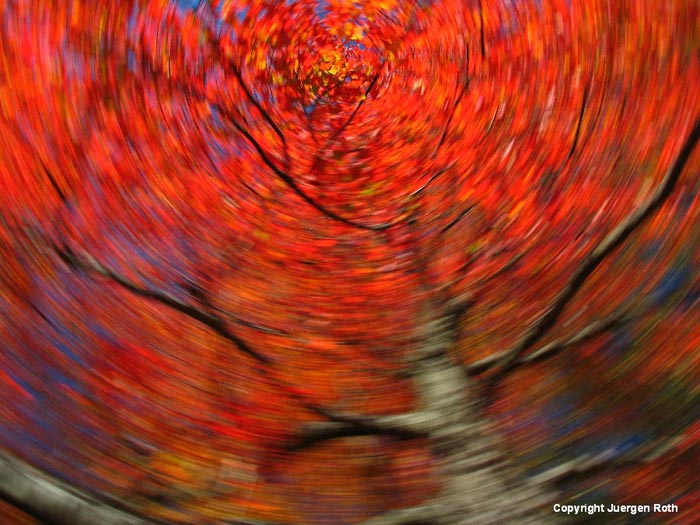
The right combination of shutter speed, aperture setting, and ISO setting in combination with the actual camera movement will produce the desired blur and an artistic abstraction of the scenery. Suppressing some or all of the details in the scene is my primary photographic goal.
“Sharpness is a bourgeois concept.” – Henri Cartier-Bresson
A long enough shutter speed is the key ingredient for intentional camera movement and allows the camera to paint the photographic object in abstract form. Multiple camera options maximize shutter speed.
Low light is a natural source, but ICM can also be used in good lighting conditions by fitting a polarizing and/or neutral density filter to the lens.
I usually start out choosing the lowest ISO setting combined with the smallest aperture setting (largest f-stop number) my camera has to offer. These camera settings will result in the slowest exposure times.
I prefer the polarizing option over a neutral density filter because it boosts color and balances the contrast; it eliminates glare and reflections.
Think of the polarizing filter as sunglasses for your camera. Overall, these filters increase color saturation, boost blue sky, add cloud contrast, control reflections, and add neutral density to lengthen exposure times for blurred, impressionistic images.
The polarizer often provides me the low shutter speeds necessary to achieve striking abstractions, while the photograph and color still pop.
To further lower exposure times, I might add neutral density filters of various grades. Anything between 1/30 second and multiple seconds can produce interesting and appealing ICM photos.
I recommend starting with slower shutter speeds, such as 1/30 to 1/2 second, before experimenting with multiple second exposure times.
“It is an illusion that photos are made with the camera,
they are made with the eye, heart & head.” – Henri Cartier-Bresson
The Advantages Of Intentional Camera Movement
One of the other great advantages of ICM is its independence from weather. When you’re performing ICM, you don’t always need to wait for the perfect morning or evening light. As with traditional photography, golden light will enhance photos, but it’s not the ultimate key to success.
Side lighting works well, because it defines one side of the photographic subject more than the other, thereby adding more interest to the overall composition.
Trees are among my favorite ICM photography objects and I generally pan in a vertical direction–in line with the tree trunks. Flowers, landscapes, seascapes, and buildings are best panned sideways following the horizon. I also experimented with moving the camera up and down to capture flowers, or I rotate the camera to capture tree canopies in fall and spring.
Smoothness of the final image is another important ingredient that is achieved by continuous movement beyond the closure of the shutter speed.
I stopped counting my failed attempts in which I hesitated and interrupted a smooth movement, therefore producing unusable photos.
Ideally, you should start moving the camera, release the camera shutter, and keep panning beyond the closure of the shutter. A camera timer (two- second setting) may help to produce a steadier and smoother abstraction while you’re moving the camera.
“Great photography is about depth of feeling, not depth of field.” – Peter Adams
After all the theory and basics of intentional camera movement, let’s look at some examples of it.

1. Intentional Horizontal or Sideways Camera Movement
For the sunset photograph, I set up my tripod at Brace Cove in Gloucester, Massachusetts. Originally, I stopped at Brace Cove to capture a sailboat anchored offshore. I wasn’t able to compose a great shot of the sailboat, so instead, I started focusing and experimenting with ICM across the cove.
After a few test shots and setting up my tripod, I exposed 1/10 second to allow for intentional camera movement across the cove, capturing this abstract seascape photograph of the beautiful sunset.
The small incoming waves beautifully reflected the orange sky while the shoreline across from me appeared dark black. During the exposure and movement of the camera, I followed the rule of thirds and laid the horizon low for a more appealing composition.
The next image represents another horizontal camera movement photograph and was taken on beautiful Cape Cod.
Here I hand-held the camera and moved it in the direction of the incoming rolling waves, producing an impressionistic early morning seascape. The aperture was set to f/8 resulting in 1/2 second exposure time.
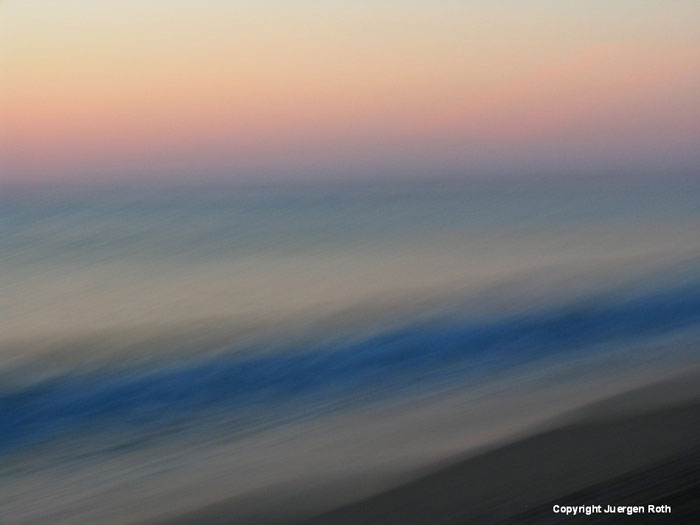
2. Intentional Vertical Camera Movement
In this next summer photo, I applied intentional camera movement to one of my flower photographs.
Here I hand-held the camera and set the aperture to f/8, providing a slow shutter speed of 1/10 second. I then focused on a bunch of Blacked-eyed Susan flowers in the garden and moved the camera up and down to create an abstract floral blur.
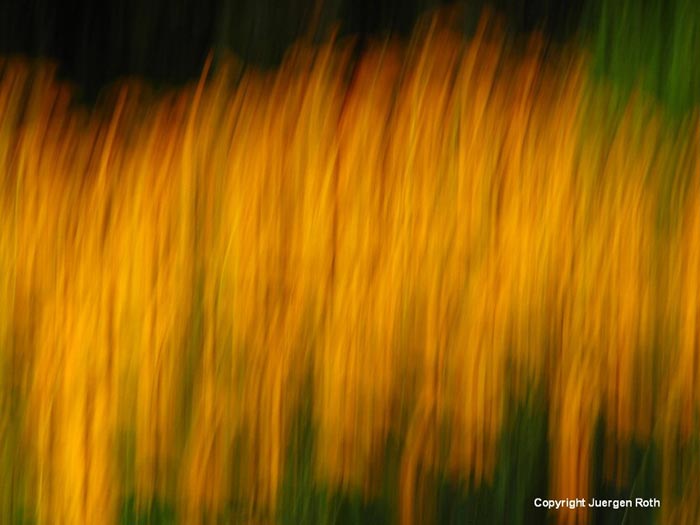
I captured the abstraction below of royal palm trees on my last trip to Florida. I didn’t have a polarizing filter or a neutral density filter available, and therefore, had to make adjustments to the speed of my camera movement.
The shutter speed in this image was actually very fast at 1/200 second and a true challenge to the moment of shutter release and camera movement.
While panning fast across the static palm trees, I released the shutter and kept moving the camera.
Although it took quite a bit of camera memory to familiarize myself with the best timing and speed of the vertical camera movement, persistence was worthwhile because in the end I painted an abstraction of palm trees that I had imagined for a long time.
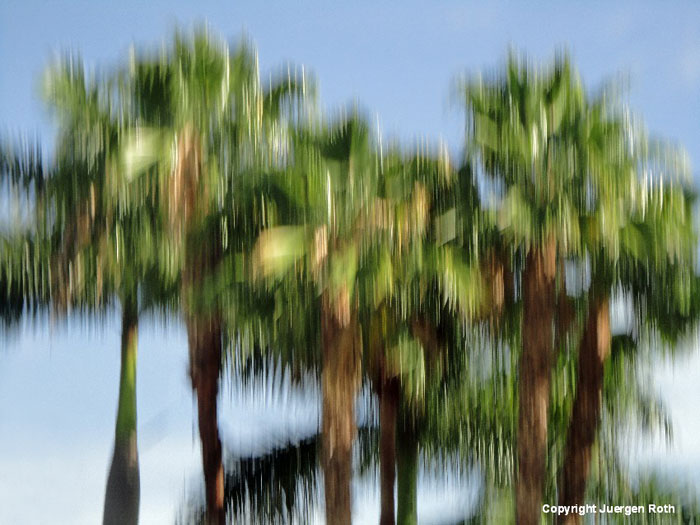
3. Intentional Rotating Camera Movement
Here I took advantage of the beautiful Boston Arnold Arboretum and its stunning trees. For both photos, I placed the camera on my tripod pointing upward towards the tree canopies. During the exposure, I rotated the camera creating these carousel-like images.
The aperture was set to f/8 resulting in 1/30 sec and 1/4 sec exposure times for the fall (lead photo above) and spring image respectively.
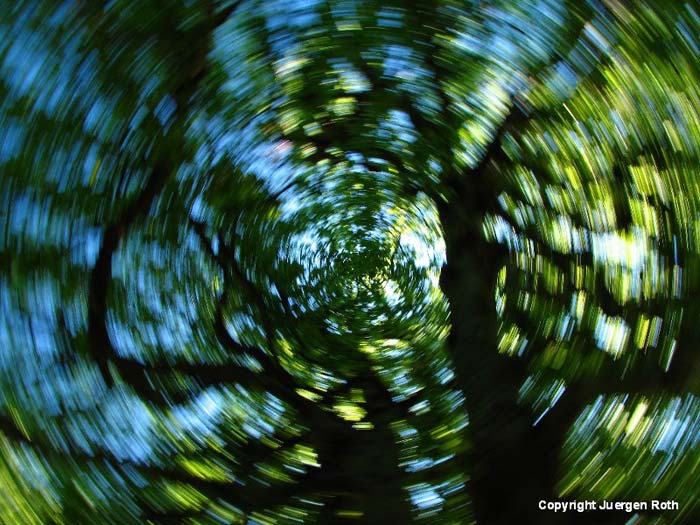
4. Post Processing and Creating Intentional Camera Movement in Photoshop
As in my traditional flower and landscape photography, in ICM I always strive to capture the optimal image within my camera and keep the software post processing to a minimum. As I’ve mentioned, I use filters, a tripod, and traditional compositional aspects to create my ICM photography image within the camera, expressing my motivation and inspiration.
I usually apply dust removal, minor contrast, lighting, and/or saturation adjustments before saving the file for my online gallery.
However, intentional camera movement may also be created by using one of the available photography software applications such as Photoshop. Here are a couple of sailboats I shot a few years ago on Martha’s Vineyard to demonstrate the work process and steps in Photoshop.

2nd image: Post processed in Photoshop

© Juergen Roth. All rights reserved.
1. First and foremost, don’t use the original file but create a copy with which to work. Under “Filter -> Blur -> Motion Blur” set the angle to 0 degree and move the distance slider to a value of your preference that suits the image best. Perform this action once, twice, or three times, depending on your personal preference and the impact on the photo.
2. Next, under “Filter -> Blur -> Gaussian Blur” smooth out the image by moving the slider to a setting that fits your personal taste. If you require more color saturation, go to “Enhance -> Adjust Color -> Adjust Hue/Saturation” and adjust the color saturation slider.
3. Before saving the image, you may consider making final level adjustment that may be conducted under “Enhance -> Adjust Lighting -> Levels”.
4. The last image below shows ICM as created in the digital lab with Photoshop.
Intentional camera movement is an exciting way to express yourself through your photography. It provides a unique opportunity in which each image is different as you release the shutter and move across the scenery in front of you.
Getting into the creative groove of the methods may take some time, and you may experience lots of trial and error in the beginning as you develop your own technique and style, but ICM will certainly provide you with unique sets of photographs.
Eventually your results will become more predictable as you gain control over the final image.
You don’t need to travel far or get out of bed early to pursue this abstract form of photography. Next time you’re out and about, simply set a long exposure time and move your camera horizontally or vertically during exposure and examine the amazing creative results. Be warned though: ICM is contagious and lots of fun!
by Juergen Roth
All text & photos: © Juergen Roth. All rights reserved.

Nice article. I am an ‘icmer’ and personally i much prefer the ‘natural’ in-camera approach rather than Photoshop, which i consider the ‘Walmart’ of the technique. I am looking forward to seing more artists getting the gist of the technique, quite awesome 😉 Carlotta Dongar